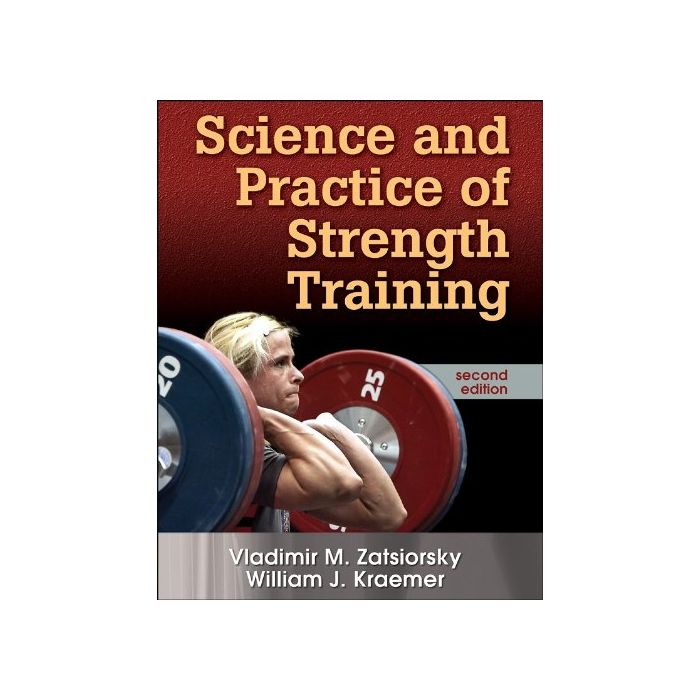Science and Practice of Strength Training
This book addresses the complexity of strength training programs while providing straightforward approaches to take under specific circumstances.
All books (hard copy and eBooks) are non-refundable and cannot be exchanged for any other item.
From Publisher:
This new second edition of Science and Practice of Strength Training comes with many additions and changes. A new coauthor, Dr. William Kraemer, joins Dr. Vladimir Zatsiorsky in expanding on the principles and concepts needed for training athletes. Among Dr. Kraemer’s contributions are three new chapters targeting specific populations—women, young athletes, and seniors—plus the integration of new concepts into the other chapters.
Together the authors have trained more than 1,000 elite athletes, including Olympic, world, continental, and national champions and record holders. The concepts they divulge are influenced by both Eastern European and North American perspectives. The authors integrate those concepts in solid principles, practical insights, coaching experiences, and directions based on scientific findings. This edition is much more practical than its predecessor; to this end, the book provides the practitioner with the understanding to craft strength training programs based on individuals’ needs.
Science and Practice of Strength Training, Second Edition, shows that there is no one program that works for any one person at all times or for all conditions. This book addresses the complexity of strength training programs while providing straightforward approaches to take under specific circumstances. Those approaches are applied to new physiological concepts and training practices, which provide readers with the most current information in the science and practice of strength training. The approaches are also applied to the three new chapters, which will help readers design safe and effective strength training programs for women, young athletes, and seniors. In addition, the authors provide examples of strength training programs to demonstrate the principles and concepts they explain in the book.
The book is divided into three parts. Part I focuses on the basis of strength training, detailing concepts, task-specific strength, and athlete-specific strength. Part II covers methods of strength conditioning, delving into training intensity, timing, strength exercises, injury prevention, and goals. Part III explores training for specific populations. The book also includes suggested readings that can further aid readers in developing strength training programs.
This expanded and updated coverage of strength training concepts will ground readers in the understanding they need in order to develop appropriate strength training programs for each person that they work with.
Chapter 1. Basic Concepts of Training Theory
- Adaptation As a Main Law of Training
- Generalized Theories of Training
- Training Effects
- Summary
- Elements of Strength
- Determining Factors: Comparison Across Tasks
- Summary
- Muscle Force Potential (Peripheral) Factors
- Neural (Central) Factors
- Taxonomy of Strength
- Summary
Chapter 4. Training Intensity
- Measurement Techniques
- Exercising With Different Resistance
- Training Intensity of Elite Athletes
- Optimal Training Intensities From Comparative Research
- Methods of Strength Training
- Summary
- Structural Units of Training
- Short-Term Planning
- Medium-Term Planning (Periodization)
- Summary
- Classification
- Exercise Selection for Beginning Athletes
- Exercise Selection for Qualified Athletes
- Additional Types of Strength Exercises
- Experimental Methods of Strength Training
- Breathing During Strength Exercises
- Summary
- Training Rules to Avoid Injury
- Biomechanical Properties of Intervertebral Discs
- Mechanical Load Affecting the Intervertebral Discs
- Injury Prevention to the Lumbar Region
- Summary
- Strength Performance
- Power Performance
- Muscle Mass
- Endurance Performance
- Injury Prevention
- Summary
Chapter 9. Strength Training for Women
- The Female Athlete’s Need for Strength Training
- Benefits and Myths of Strength Training for Women
- Trainable Characteristics of Muscle
- Physiological Contrasts Between Women and Men
- Strength Training Guidelines for Women Athletes
- Incidence of Injuries
- Menstrual Cycle and Strength Training
- The Female Athlete Triad
- Summary
- Safety and Strength Training for Young Athletes
- When to Start
- Benefits of Strength Training for Young Athletes
- Myths of Strength Training for Children
- Strength Training Guidelines for Young Athletes
- Summary
- Age and Its Effects on Strength and Power
- Training for Strength Gains
- Training for Muscular Power
- Nutrition, Aging, and Exercise Challenges
- Recovery From Resistance Exercise
- Strength Training and Bone Health
- Strength Training Guidelines for Senior Athletes
- Summary
A reference for strength and conditioning specialists and researchers and exercise physiologists. Also a course text for graduate-level students in strength and conditioning courses and exercise physiology courses.
Hardback Book
264 pages









